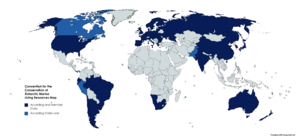Convention for the Conservation of Antarctic Marine Living Resources facts for kids

Logo of the Commission for the Conservation of Antarctic Marine Living Resources
|
|
| Abbreviation | CCAMLR |
|---|---|
| Formation | 20 May 1980 |
| Type | International organization |
| Purpose | Environment |
| Headquarters | Hobart, Australia |
|
Area served
|
Antarctic |
|
Membership
|
26 Member States + 11 Acceding States |
|
Executive Secretary
|
Dr David Agnew |
The Commission for the Conservation of Antarctic Marine Living Resources, often called CCAMLR, is an important group that helps protect marine life around Antarctica. It's part of a bigger agreement called the Antarctic Treaty System.
CCAMLR started on 7 April 1982. Its main office is in Hobart, Tasmania, Australia. Its big goal is to keep the ocean and its creatures healthy in and around Antarctica.
This group was formed because people were worried that too much krill was being caught in the Southern Ocean. Krill are tiny creatures that many other animals, like whales and penguins, eat. If there wasn't enough krill, it could harm many other animals.
In 1989, CCAMLR started a special program called the Ecosystem Monitoring Program (CEMP). This program helps them watch how fishing affects different species in the area.
On 19 October 2022, Ecuador joined CCAMLR. It became the 26th member country.
Contents
Who Are the Members of CCAMLR?
CCAMLR has many member countries and others that agree to follow its rules. These countries work together to protect the Antarctic ocean.
| Member States | Acceding States (follow rules) |
|---|---|
Protecting Ocean Areas: MPAs
In 2009, CCAMLR decided to create special safe zones in the ocean called Marine Protected Areas (MPAs). These areas help protect marine life. This was a big step, as CCAMLR was the first international group to do this.
By 2011, they had picked nine main areas to plan these protected zones.
| Marine Protected Area | Size | Status | Proposed by | Designated |
|---|---|---|---|---|
| South Orkneys | 94,000 km2 | Designated | United Kingdom | 2009 |
| Ross Sea | 1,550,000 km2 | Designated | New Zealand, United States | 2016 |
| East Antarctica | 950,000 km2 | Proposal | Australia, France, European Union | N/A |
| Weddell Sea | 1,800,000 km2 | Proposal | Germany, European Union | N/A |
| Antarctic Peninsula | 450,000 km2 | Proposal | Argentina, Chile | N/A |
South Orkneys MPA
In 2009, CCAMLR agreed to create the world's first MPA in the open ocean. This area protects the waters around the South Orkney Islands in the south Atlantic Ocean.
The United Kingdom suggested this MPA. It covers a huge area of 94,000 square kilometers. This protected zone started in May 2010.
Ross Sea MPA
In 2010, both the US and New Zealand suggested creating an MPA in the Ross Sea. Later, they combined their ideas into one plan.
In July 2013, CCAMLR had a special meeting to talk about MPAs for the Ross Sea and East Antarctica. But they couldn't agree because Russia voted against the plans. Russia was unsure if CCAMLR had the power to create such a large protected area.
However, on 28 October 2016, after many years of talks, CCAMLR finally agreed to create the Ross Sea marine protected area. This happened at their yearly meeting in Hobart. This protected area is enormous, covering 1.55 million square kilometers of ocean.
About 72% of this area is a "no-take zone," meaning no fishing is allowed. In the other 28%, some fishing for fish and krill is allowed, but only for scientific research.
The Ross Sea MPA will be protected for 35 years. In 2052, CCAMLR members will decide if they want to continue or change it.
East Antarctic MPA
In 2010, Australia, France, and the European Union suggested an MPA for East Antarctica. Their first idea included seven different areas with different levels of protection. It covered 1.8 million square kilometers of ocean.
By 2017, the plan was changed to include only three areas, covering just under 1 million square kilometers. This change happened because some member countries had concerns about politics and money. The plan was also updated to last for 30 years and to be reviewed every ten years. CCAMLR has been thinking about this proposal since 2012.


